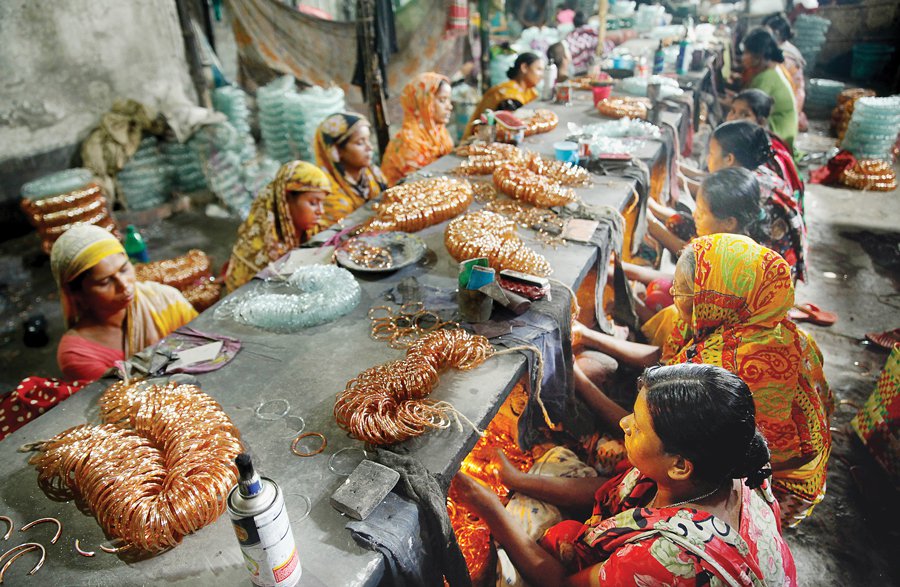Published in Dhaka Tribune on November 8, 2017

Photo: Syed Zakir Hossain/ Dhaka Tribune
‘The participation of women in the economy may have increased, but they are mostly in low-paid and low-skilled jobs’
The recorded success of Bangladesh in reducing gender inequality is being skewed by the high proportion of women at the top of the political ladder and the reliance on cheap female labour in the garment industry, analysts have said.
The World Economic Forum’s Global Gender Gap Report released on November 2 revealed that Bangladesh leads South Asia in terms of gender equality.
The report benchmarked 144 countries on their progress towards gender parity across four areas: economic participation and opportunity, educational attainment, health and survival, and political empowerment.
A closer inspection of the report, however, reveals that Bangladesh owed its high ranking mostly for its achievements in political empowerment of women, for which it was ranked as high as No.7 in the world by the WEF.
The country performed poorly in other areas and was ranked only 124 in labour force participation, 104 in wage equality, 108 in earned income, and 106 in legislators, professionals/technical workers.
“If the report is based on the Prime Minister, opposition leader, and speaker of the parliament, or a minister of one or two ministries, then it does not reflect the reality on the ground,” BNP’s Assistant Secretary for International Affairs Rumeen Farhana said.
“At the root level, the picture is very different. If you only think about the top of the pyramid then yes, things are good. But other than that, you will not find any empowerment of women because when a woman has no economic, social or decision-making right and power, then the foundation cannot be strong.”
A skewed picture
Bangladesh cemented its position in the WEF rankings as the top performing country in South Asia on gender issues, climbing to No.47 on the global list from last year’s ranking of 72.
However, this masks Bangladesh’s continued struggle with violence against women, wage disparity, high dropout rates among female students in primary and secondary schools, and the absence of women in top bureaucratic positions.
“Just based on political participation, we cannot say we have improved,” Action Aid Bangladesh Country Director Farah Kabir said.
“There are still high rates of child marriage that causes early child births, and there are gaps in access to health. Women are lagging behind in education and literacy, where enrollment does not reflect the real scenario.”
The literacy rate for women in Bangladesh is 54%, according to the 2016 “Education Watch Report” by the Campaign for Popular Education (CAMPE).
And yet, in the last budget, the secondary and higher education budget for women was reduced from Tk8,625 crore to Tk7,234 crore.
The cutbacks do not stack up against the statistic that two out of every five girls aged between 15 and 19 drop out of school, according to BBS data from 2015.
“Girls stop going school because of sexual harassment and we hear news of violence against women every day,” Farah Kabir said.
Gender-based violence still rife
According to the Violence Against Women (VAW) chart compiled by the women’s rights organisation Bangladesh Mahila Parishad, 183 children were married off from January to October this year, compared to 184 in 2016.
Rights groups say that over 5,000 women have died from dowry-related violence since 2001, say rights groups.
In addition, the human rights NGO Ain O Salish Kendra says that so far in 2017, a total of 33 women have been killed and 11 have committed suicide after being raped.
A BBS study in 2011 stated that 87% of married Bangladeshi women are abused by their husbands, while an ICDDRB study this year said 70% of women are victims of intimate partner violence.
“Women are lagging behind because of a lack of awareness,” said Shamsunnahar Chapa, the Awami League’s Education and Human Resource Affairs Secretary.
An Action Aid study titled “The cost of inequality in women’s work” found that the average earnings of women in Bangladesh are 60% of those of men for the same amount of work.
“The participation of women in the economy may have increased, but they are mostly in low-paid and low-skilled jobs,” said Centre for Policy Dialogue Distinguished Fellow, Professor Rounaq Jahan.
According to BBS estimates, 33.5% of the labour force in Bangladesh is female.
Professor Rounaq Jahan said: “Generally, women are not present in top tier jobs because there is no supply or they are overlooked in favour of men.”
Centre for Policy Dialogue Research Director, Dr Khondaker Golam Moazzem, said the gender gap indicators are being skewed by the high proportion of women working in the ready-made garments (RMG) sector.
“They only take into account a part of female employment – RMG – while the performance across the rest of the key economic indicators is very poor,” he said. “(This) contradicts the popular belief of the rise of economic empowerment of women in Bangladesh.”
Additional Secretary to the Women and Children Affairs Ministry, Mizanur Rahman, however, said the WEF report reflects the government’s success in working with gender rights.
“Women’s development is third on the list of the government’s 10 priorities,” he said. “The aim is to increase female participation in the economy and politics, prevent child marriage, and bring women in need under social safety net projects, and life-skill oriented training programmes.”
Mizanur expressed his hope that by 2025, Bangladesh will be able to achieve full gender equality.
Former Bangladesh National Women Lawyers Association (BNWLA) executive director Salma Ali said: “A social transformation is taking place but our efforts are still inadequate. We still need to address the gaps in rights.”
 CPD RMG Study Stitching a better future for Bangladesh
CPD RMG Study Stitching a better future for Bangladesh




